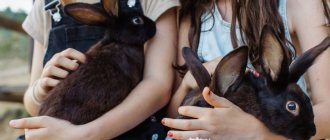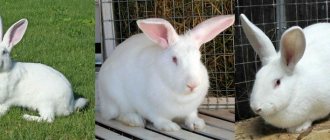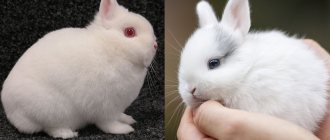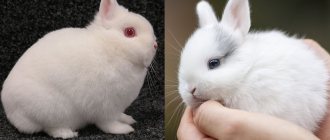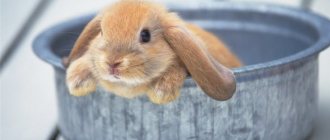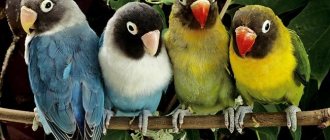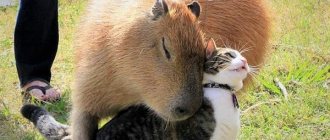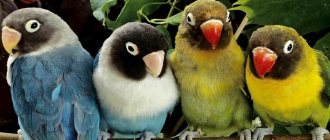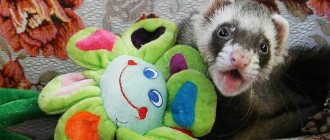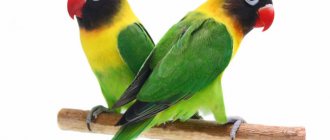- home
- Rabbits
- Breeds
10/07/2018 Breeds of decorative rabbits amaze with their diversity and quantity. When choosing a furry friend, potential owners' eyes widen. Often, when choosing an animal, rabbit breeders are guided not only by the appearance of the rodent. To choose the one that is suitable based on the external characteristics, characteristics of care and maintenance of the pet, you should carefully study all the possible options.
What's so great about the Dwarf Ram?
The hanging ears of the decorative rabbit of the Dwarf Ram breed immediately attract the attention of animal lovers. Such pets become the soul of family comfort and the center of attention at any children's party. True, the ears do not immediately become floppy. Initially, individuals are born with erect ears, and only by 3 weeks do they begin to gradually droop.
Rabbits of the Dwarf Ram breed
The wool of Dwarf Rams is plush and of medium length. Dense and soft, the color can be different, there are a lot of color varieties. The body is squat, the weight of such a rabbit can reach up to 2 kg with normal feeding. A feature of the breed, in addition to drooping ears, is their length, reaching 25 cm! This is a rare indicator for dwarf type breeds.
The last thing worth mentioning is character. He is easy-going, calm, simple, friendly to everyone. Such a pet will get along without problems not only with people, but also with other animals and even birds.
Rex rabbits
Also check out these articles
- Amur grape variety
- How to process cabbage
- Plumeria flower
- When to dig up garlic?
The Dwarf Rex is an amazing creature, primarily striking for its fur. It is almost 2 times shorter than that of ordinary individuals, but just as plush, soft and shiny.
Dwarf Rex
This breed of decorative rabbits has a strong bone structure and an almost round head. Erect ears, shortened paws and neck. Eye color can be any, just like coat color. Natural weight reaches 1 kg, but no more.
The character is usually calm, but it all depends on the situation. The rabbit will not allow itself to be tormented, so it is not worth giving it to small children who have not yet learned how to behave with animals, but you can pet Rex with the children. They love children, they just can't stand being mistreated.
Maintenance and care
Rex rabbit unusual fur. Having the advantages of expensive types of fur, it is easy to obtain and therefore has a lower cost. A variety of natural colors offer a huge selection of models. A coat or fur coat made from a Rex rabbit is a smart investment. After all, such a thing will be worn for a long time and will not go out of fashion.
The Rex body is distinguished by its consumption of large amounts of oxygen and intense metabolism. They tolerate cold well (down to -20 degrees), but are sensitive to overheating and direct sunlight. They are contraindicated in high humidity, drafts, dampness, and high levels of dust and carbon dioxide in the air.
Ideal conditions for rex: humidity 50%, temperature +18/+20 degrees.
To breed this breed, 3 types of cages are used. Single: for males or young animals, and queen cell - a single cage and a brood box attached to it. They all complement each other. Each cage has a 4-liter float drinker, a hopper feeder, a corner hay bar, a door and a pull-out tray. This breed has a high predisposition to a disease such as pododermatitis (weak edge of the feet of the paws). They cannot be kept in cages with mesh floors, because... Ulcers may appear on the limbs. Therefore, they should have thick straw bedding, and the floors in the cages should be slatted (made of waterproof plywood 10 mm thick). There should always be clean water. Daily feed intake: 30-40 grams per 1 kg of weight, water: 100 ml per 1 kg of weight.
Their diet should include hay. In summer you need to add dried grass. Rabbits must be vaccinated when they are at least 35 days old and weigh at least 500 grams. Vaccinated against viral hemorrhagic disease and viral disease myxomatosis. The baby rabbit must be healthy and dewormed.
Feeding
The basis of the daily diet is always fresh hay and dry pellets 3 times a day. Aspen or birch bark is excellent for sharpening teeth. As the wood grinds down, it is necessary to change it. Features of the daily menu depend on the time of year:
- In the summer, give your rabbits more fresh grass, fruits and vegetables, and do not forget about fortified feed and the benefits of hay.
- In winter, feed rabbits with compound feed (65% of the daily menu), hay, tree branches, root vegetables, and a mixture of grain crops.
Dill, parsley, cauliflower, carrots and the tops of this root vegetable are especially useful for rabbits. Select vitamin and mineral supplements individually and buy them from veterinary pharmacies.
Hygiene procedures
The decorative Rex rabbit is a short-haired animal that requires minimal care. But it is still necessary to periodically carry out basic hygiene procedures for your pet:
- combing with a brush or cloth;
- washing the eyes with warm water;
- cleansing the ears with cotton wool soaked in boric alcohol;
- nail trimming.
05:06
HOW TO CUT A RABBIT'S CLAWS? DOES A RABBIT'S CLAWS NEED TO BE CUT?
07:11
How to trim the claws of a decorative rabbit? The easy way!
10:09
HOW TO CUT THE CLAWS OF A DECORATIVE RABBIT? HOW TO TRIM A RABBIT'S CLAWS YOURSELF?
Possible diseases and their prevention
Rex dwarfs get sick along with other ornamental relatives, although they have increased body resistance. Among the pathologies there are diseases of both infectious and non-infectious origin.
The most common diseases are:
- VHBK (viral hemorrhagic pathology);
- myxomatosis;
- tympanitis;
- constipation or diarrhea;
- runny nose;
- abscesses;
- diabetes;
- conjunctivitis.
Timely vaccination, periodic examination by a veterinarian, disinfection of cages with equipment, and proper nutrition will help reduce the risk of developing pathologies.
Fox dwarf rabbit
Fox dwarf rabbits are very cute, kind and quiet, although there are also very active individuals. They are very demanding in terms of care; they need not only proper feeding, cleanliness, but also attention.
Fox dwarf rabbit
The body of these decorative breed rabbits is strong and small. The head is rounded, slightly elongated, the neck, paws and erect ears are short, the eyes are bulging, round and large. Normal weight is up to 1.5 kg; if the animal weighs more, then it is worth adjusting its diet.
The fur is long, so the rabbit needs regular brushing. There are different colors, but the most popular variations are red (like a fox).
Breeding and its subtleties
Rexes do not have good fertility abilities. The female gives birth to only 4-6 cubs. At the slightest failure to comply with the conditions, the babies quickly die. Therefore, animals require reliable protection and care.
02:36
Breeding Rex rabbits as a business idea | Rex Rabbits
10:19
Rabbits of the Rex breed, description of the breed.
08:47
Rabbits of the REX breed. 4 years of maintenance.
In terms of external features, Rex cubs are not distinguished by their beauty; they even look unsightly. The offspring acquire characteristic thoroughbred features as they grow up.
It is not necessary to be present near the mother in labor during the birth of the rabbits. However, during the first birth, the rabbit needs to be accompanied by the process. The future nurse of her offspring may not prepare the nest. Such behavior in frequent cases causes the sudden death of rabbits. In order to prevent such an outcome, the owner of the farm must provide the female with a large amount of water before lambing.
So that the babies can safely feed on mother's milk, it is recommended that the expectant mother develop nipples before giving birth, otherwise the babies can cause severe pain to the first-born mother and cause anger.
Small representatives of Rex need to be looked after more seriously. If the behavior of the mother rabbit towards the cubs is negligent, support for the further growth and existence of the offspring should be provided in the form of a suitable temperature regime. You can install a lamp in the cage as a heat source.
During the autumn cold weather, creating a nest will help. If you feed newborn Rex properly, the babies are more likely to survive. In the absence of natural mother's milk, the babies are nursed using artificial formulas or placed with another lactating female.
Condensed milk or a special mixture is often suitable as a replacement for natural milk. The cubs need to be fed once a day for 21 days. When the kids grow up, they are switched to a plant-based diet.
It is quite difficult for new rabbit breeders to provide proper care during breeding. In order for the offspring to survive and grow fully, additional consultation with a professional will be required.
Signs of culling
If the animal is stroked against the grain, the fur is elastic and elastic and immediately returns to its original position. When this does not happen, the purity of the breed raises some doubts.
If a rabbit weighs less than 2 kg and more than 5 kg , this is another sign of culling. Such individuals are not suitable for procreation. The same applies to passive and lethargic animals, since it is possible that they are sick. Other signs of culling Rex rabbits:
- drooping, thin ears;
- bald patches on the body;
- fur length more than 2.4 cm;
- presence of a double or triple chin;
- ear length more than 13 cm;
- poor hair development.
What are the characteristics of Hermelin rabbits?
We recommend reading our other articles
- The best dairy cow breeds
- Percheron horse breed
- Cochin chicken breed
- The best varieties of Nectarine
Rabbits of the Hermelin breed are among the most beautiful. They have a rounded head, red or blue slightly bulging eyes, and small erect ears. The body is small but strong, the legs and neck are very short.
Rabbit breed Hermelin
The coat is medium length and only white! Weight can reach up to 1 kg. As for character, Hermelins have a friendly and calm disposition; “fighting” individuals are very rare.
Colored dwarf
The short-haired dwarf rabbit, or as it is more often called the Colored Dwarf, has a variegated fur color, which attracts attention. The color variety of this breed of decorative rabbits is enormous! There are individuals black and white, blue, yellow, red, Siamese, agouti, purple with different shades and a mixture of tones.
Colored dwarf
The colored dwarf comes from Holland, where it was bred from Polish colored rabbits, which they are very similar to. The physique is strong, although the rabbit itself looks very small. It has short legs, ears, neck and a massive hindquarters. The ears stand straight on the round head. The eyes are bulging and large, like in principle all decorative rabbits. The weight of individuals rarely exceeds 1.5 kg, and even then such a weight can only be observed in males. Females are much smaller - up to 1 kg.
The coat is of medium length - up to 4 cm. The character is soft, but in terms of mobility there is a lot of variety. Some members of the species are quiet, while others are very active. This breed is the most common throughout the world.
Lion head
The lion-headed rabbit can reach a weight of up to 1.7 kg. This variety was bred in Belgium. It is distinguished by long rollback fur that covers the entire body of the animal equally. It can be different in color; the most interesting colors are chinchilla, orange, blue, opal, and sable.
The physique of lion-headed individuals is compact. The body is round. The chest is wide. The limbs are strong and well developed. On the short neck there is a neat head with short vertical ears - 8-9 cm. On the neck and back of the head, a mane is formed from wool - single or double.
Because very often the lion's head turns into an affectionate and docile pet, even a beginner can have this rabbit. If you are gentle and attentive with him, he will be energetic and inquisitive, obedient and playful. But it is not suitable for small children. Once frightened or stressed, he may subsequently behave aggressively towards them. However, it can also express aggression if it spends a long time alone. You should also remember that the breed is still in its development stage, so you may encounter unfriendly individuals from the very beginning.
On average, lionhead rabbits live seven to nine years. Their price starts from 20 dollars .
What other breeds can be classified as decorative?
At the moment, only five of the above-mentioned types of decorative rabbits are officially recognized in the world. But there are also unofficial breeds of decorative rabbits that are in no way inferior to their recognized relatives.
- The dwarf hare is a breed of rabbit with red eyes. Their color is white with dark ears and small spots in the muzzle area of the same color. But these rabbits are always born white and only over time do they develop black spots. They weigh quite a lot - up to 2 kg; they are often bought if there is already some kind of pet in the house.
- The Angora dwarf rabbit looks quite remarkable.
It is very easy to distinguish it from all other breeds of decorative rabbits by the abundance of long, fluffy fur. It seems to completely envelop the animal, making it difficult to even distinguish the eyes and muzzle. Angoras have erect, short ears that peek out from the shock of fur. The head is round, the eyes are slightly bulging and this is easy to see if you remove the fur from the muzzle. Unofficial breeds of decorative rabbits - The dwarf butterfly is a decorative rabbit, the name of which is closely related to the color of the fur - the color is symmetrical on both sides of the body. In appearance they look like a dwarf hare, only the body is more elongated. Weight rarely reaches 1.8 kg. Color black and white, white-black-yellow and other variations.
- The Lionhead is a very unusual breed. The name largely determines the appearance of the individuals, whose head resembles a lion’s mane. It is noteworthy that the longest hair grows on the head, and on the rest of the body it is shorter. Even the facial features may slightly resemble a lion's muzzle - a long straight nose, a pronounced muzzle, bright eyes. These are strong miniature creatures with short ears and paws weighing up to 1.2 kg.
- The dwarf Dutch rabbit is a Dutch decorative breed of rabbits that look exactly like their larger counterparts, the Dutch rabbits. The difference is mostly only in size - dwarf individuals weigh from 500 to 1000 grams. Colors: black, blue, series, brown with white chest, withers and paws.
